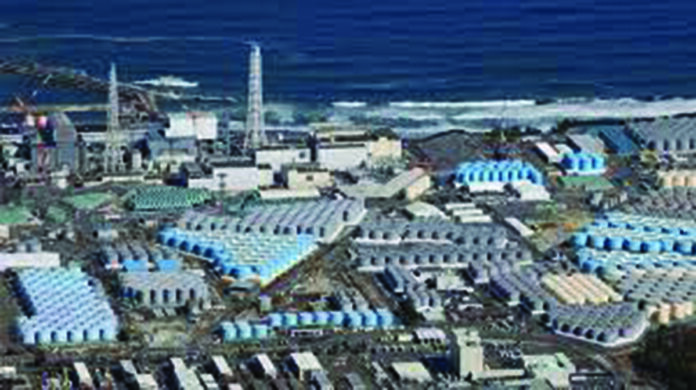Following clearance from the United Nations’ nuclear inspector for a controversial proposal that comes 12 years after the Fukushima nuclear catastrophe, Japan will soon start discharging treated radioactive water into the ocean. The environment minister stated in 2019 that there were “no other options” as space to contain the tainted material runs out. The idea to release purified wastewater has been in the works for years.
The head of the International Atomic Energy Agency (IAEA), Rafael Grossi, came to Japan to tour Fukushima and provide Prime Minister Fumio Kishida with the IAEA’s safety assessment. However, the UN’s approval hasn’t done much to calm concerned people of neighbouring countries or local fishermen who are still suffering the effects of the 2011 disaster. The IAEA’s conclusions have been questioned by some, with China most recently claiming that the organization’s evaluation “is not proof of the legality and legitimacy” of the wastewater release from Fukushima.
The Fukushima nuclear facility’s power and cooling systems were destroyed by the severe earthquake and tsunami of 2011, which led to reactor core overheating and the contamination of plant water with extremely radioactive material. Since then, fresh water has been pumped into the reactors to cool the fuel debris. Additionally, groundwater and precipitation infiltration have increased the amount of radioactive wastewater that Tokyo Electric Power Company (TEPCO), a state-owned energy provider, has to contain and for which it constructed more than 1,000 huge tanks to hold the 1.32 million metric tons of wastewater that are currently present— enough to fill more than 500 Olympic swimming pools. But there isn’t much room left. The corporation claims that adding more tanks is not an option and that to safely decommission the plant, which entails decontaminating buildings, demolishing structures, and completely shutting down operations, space must be made available to store and clean.
Certain dangerous chemicals are present in radioactive wastewater, but most of these can be eliminated from the water, according to TEPCO. The main problem is a non-removable hydrogen isotope called radioactive tritium. The technology to do so is not yet available. The polluted water, according to the IAEA and the Japanese government, will be gently discharged over decades and will be much diluted. According to them, this means that the concentration of tritium discharged would be on par with or less than the amount other nations permit and would comply with all applicable international safety and environmental rules. Tritium occurs naturally in the environment, including rain, seawater, tap water, and even the human body, according to TEPCO, the Japanese government, and the IAEA. Therefore, releasing small amounts into the sea will be safe.
According to Grossi’s statement in the IAEA report, treating water for discharge into the ocean will have “negligible radiological impact on people and the environment.” But experts are divided on the risk this poses. Tritium is too weak to penetrate the skin, according to the Canadian Nuclear Safety Commission, but if taken in “extremely large quantities,” it can raise cancer risk. While stating that “any radiation exposure could pose some health risks,” the US Nuclear Regulatory Commission also stated that “everyone is exposed to small amounts of tritium every day.”
IAEA must review its evaluation of the Fukushima nuclear plant water waste because it failed to consider the long-term effects of the wastewater release on the environment and human health and that it could serve as a precedent for other nations to dispose of nuclear waste in the ocean. Japan should abandon its discharge plans and cooperate with its neighbors to find safer ways to handle the wastewater, including the prospect of long-term on-land storage.
The Fukushima nuclear discharge of radioactive water has a terrible impact on sea life and the environment. The proposal has long been opposed by the Japanese fishing unions, who claim that it would destroy the efforts made after numerous nations banned some Japanese food items following the 2011 disaster. Over the years, some neighbors have also voiced concerns about the danger to the maritime environment and human health, with Beijing emerging as the biggest opponent.
One of a group of international scientists working with the Pacific Island Forum to evaluate the wastewater release plan includes Robert H. Richmond, director of the Kewalo Marine Laboratory at the University of Hawaii at Manoa. This work includes visits to the Fukushima site and meetings with TEPCO, Japanese authorities, and the IAEA. Richmond analyzed the plan’s specifics and deemed it “ill-advised” and “premature.”
Another concern is that the wastewater’s influence on marine life would not be sufficiently reduced by diluting it. Tritium is one example of a pollutant that can flow through different organisms in the food chain, such as bacteria, plants, and animals, and then be “bio-accumulated,” or built up in the marine ecosystem. Pollution, overfishing, ocean acidification, and climate change are already putting stress on the world’s oceans. It should not be considered a “dumping ground,”. Additionally, the dangers could spread outside the Asia-Pacific region. According to a 2012 study, Bluefin tuna may have traveled from Fukushima to California carrying radionuclides, which are radioactive isotopes similar to those found in nuclear waste.
IAEA must review its evaluation of the Fukushima nuclear plant water waste because it failed to consider the long-term effects of the wastewater release on the environment and human health and that it could serve as a precedent for other nations to dispose of nuclear waste in the ocean. Japan should abandon its discharge plans and cooperate with its neighbors to find safer ways to handle the wastewater, including the prospect of long-term on-land storage.






















